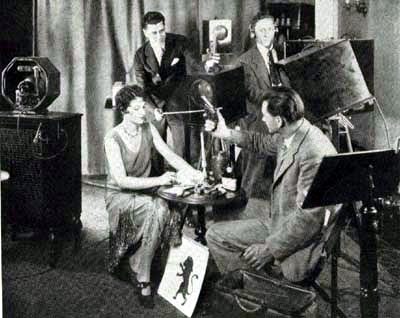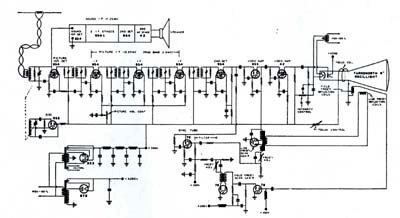 |
| a) Very rare photography of an early
1929 telecast from General Electric's WGY studios in Schenectady.
Radio News |
The high-frequency oscillation radiated
by the transmitter could be modulated in accordance with the
variations in beam current of the television camera, and thus
it was possible the wireless transmission of audio and video
signals. However, since the image was scanned in very high
speed, in order to avoid the flickering effect, the zigzag
pattern on the screen must be repeated 25 times per second.
In the same time to ensure sufficient image sharpness, it
was necessary that 500.000 dots on the screen should be scanned
and reproduced, meaning that an information datum should pass
about 25 x 500000 = 12.500000 times per second. As aforeseen
the movement of the electron beam in the kinescope was rapid
enough, however, to ensure a satisfactory reproduction of
the video signals transmission was only possible if the transmission
frequency were a multiple of the modulation frequency. In
this way through many theorical and practical researches the
engineers soon found that for the proper video signals transmission
it was necessary a minimum frequency of 50 MHz, or a maximum
wavelenght of 6 meter. The development of the new field of
ultra shortwave radio, giving birth of the so-called high
frequency valves, which largely contributed to
 |
| (b) The all-electronic television
system developed by Farnsworth circa 1937. |
handle the transmitting and receiving
of the video signals in such frequency range. As aforementioned,
since 1929 television transmissions had taken place in Europe,
initially by using mechanical system with rotating mirrors.
However, Philo Farnsworth in the USA developed the first all-electronic
television system. (b) The beginning of the WWII put an end
to the so many researches in the television field. In 1946,
just after the war, the first transmissions systems using
405, 525, 819 and 625 lines per second were standardized and
adopted respectively by England, USA, France and other European
countries. Around 1950 the black and white televison was already
an important mass communication mean. However, another fanstastic
technological step was under preparation in many researches
laboratories all over the world through the development of
the wireless transmission of the colored images.
|